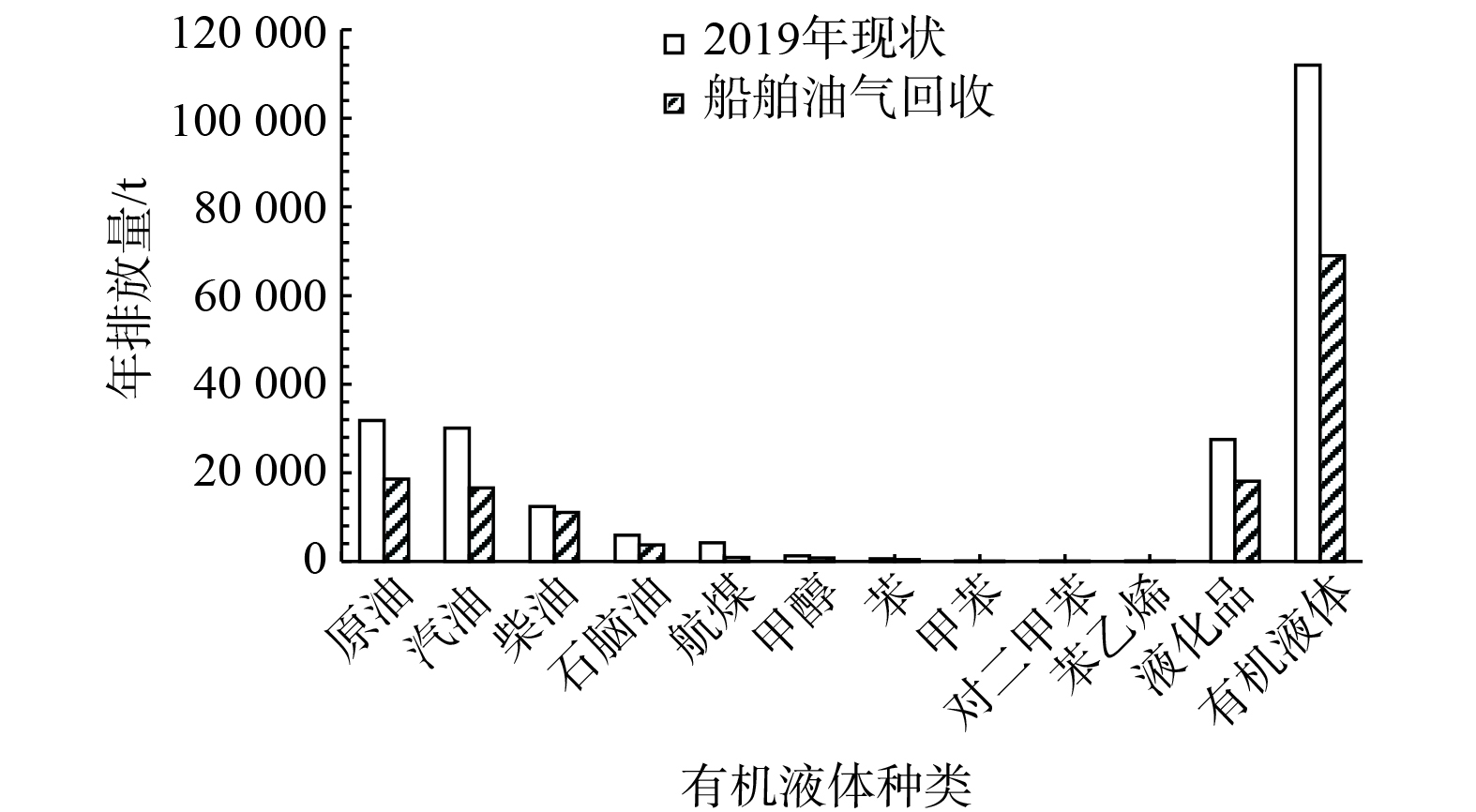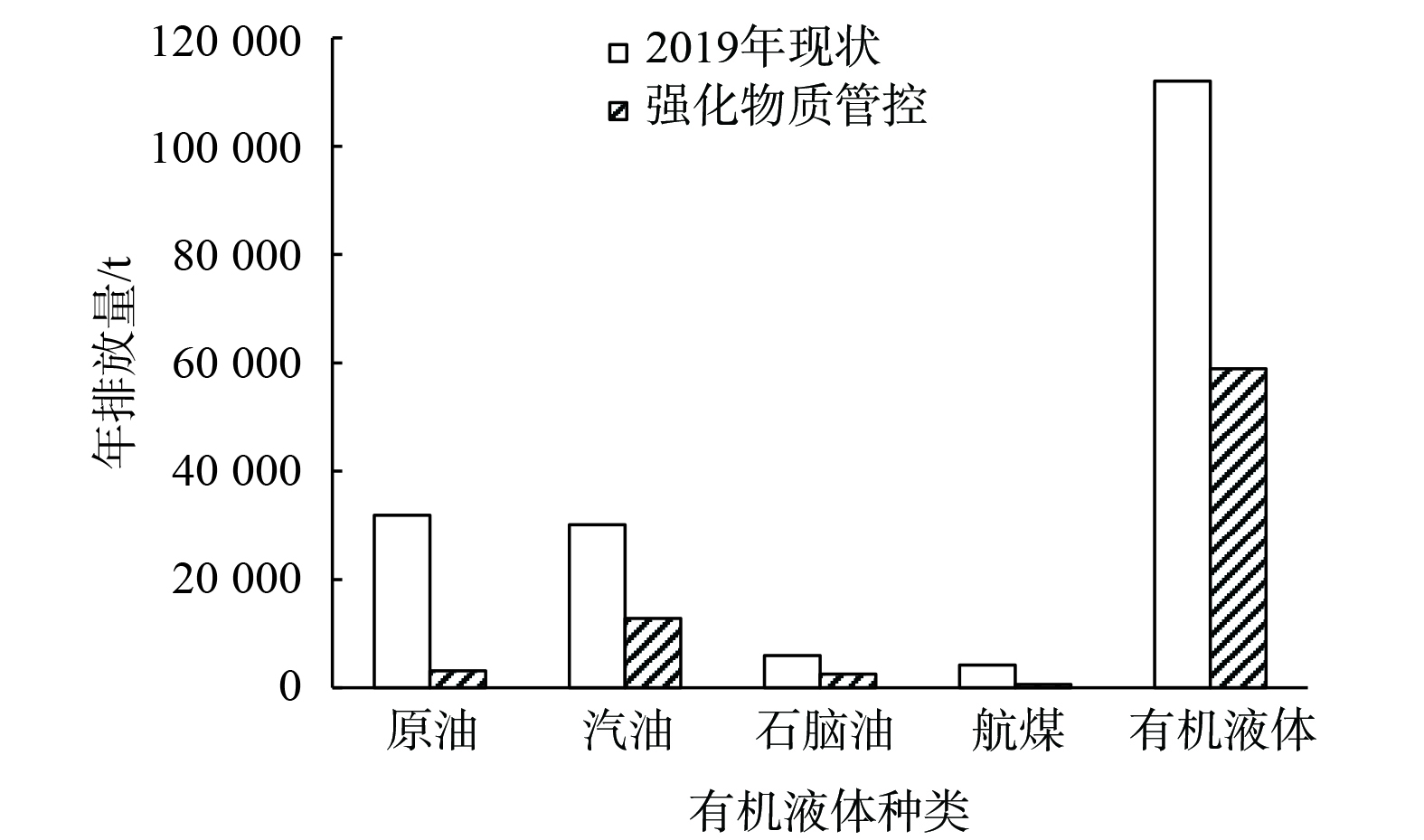-
挥发性有机物 (volatile organic compounds,VOCs) 是大气中臭氧 (O3) 和细颗粒物 (PM2.5) 污染的重要前体物。为控制VOCs排放,促进O3和PM2.5协同防控,改善大气环境质量,生态环境部于2020年11月启动“O3和PM2.5复合污染协同防控科技攻关”。其中,石油石化挥发性有机液体装载 (不涉及运输环节的逸散) 为我国VOCs的重要排放源项 (以下简称装载源项VOCs) 。由于缺少全国层面装载方式及其装载量等基础统计数据,管控策略的制定缺乏关键性支撑。因此,及时开展现状调查,梳理存在问题,结合减排潜力测算,有的放矢提出减排途径,确保减排途径及相关政策建议的有效性和可达性,可为我国O3和PM2.5精准协同防控提供参考。
本文梳理挥发性有机液体的特点,并分析其在装载源项VOCs污染排放现状,并根据装载源项VOCs的治理现状、标准要求及减排潜力分析等,提出适应当前我国相关领域的装载源项VOCs的减排策略,为我国石油石化领域装载环节的VOCs污染管控提供参考。
-
VOCs为任何能向大气释放挥发性有机物的有机液体,其主要特征为:1) 当温度为20 ℃时,VOCs的真实蒸气压大于0.3 kPa;2) 当温度大于20 ℃时,混合物中,真实蒸气压大于0.3kPa的纯有机化合物的总浓度等于或者高于20% (重量比) [1-3]。美国AP-42“有机液体储存”章节中罗列了部分石油液体和石油化工产品,其中石油液体13种,石油化工产品186种[4]。石油液体主要有原油、汽油、航煤、柴油、石脑油、燃料油、渣油等,石油化工产品主要有苯、甲苯、二甲苯、苯乙烯、甲醇、乙醇、乙二醇、丙酮、乙醛等。
参照美国AP-42有机液体分为混合物的液体石油产品和单物质的液态有机化工产品分类思路,综合消费量、真实蒸气压和单物质最大增量反应活性 (Maximum Incremental Reactivity, MIR) 三类影响光化学反应的关键性因素,选取大宗挥发性有机液体,开展装载源项VOCs排放及减排潜力相关研究。并以所选大宗挥发性有机液体现状调查为基础,估算全国层面挥发性有机液体排放和治理情况。在美国AP-42中所列的13种液体石油产品中,取消费量和真实蒸气压乘积较大的原油、汽油、柴油、煤油、石脑油为本研究的对象。在186种液体有机化工品中取大宗基础化工产品和合成纤维单体及化工原料[5],按消费量、真实蒸气压、最大增量反应活性 (MIR) 三因素乘积排名前五的苯、甲苯、二甲苯、甲醇、苯乙烯为本研究的对象,总计十种物质。根据油气市场及相关物性资料[5-9],调查10种典型有机液体2019年消费量、真实蒸气压、最大增量反应活性见表1。
-
我国挥发性有机液体主要的运输工具有管道、汽车、火车、船舶四类。在装载过程中,汽车、火车和船舶罐槽内的烃蒸气被挥发性有机液体置换时产生VOCs排放。而挥发性有机液体管道装载源项VOCs逸散与火车、汽车、船舶装载相比,可忽略不计。在运输工具方面,挥发性有机液体呈现3种类型:第一为原油,消费量大,以国外进口为主,国内船舶转运量大;第二为成品油,消费量其次,国内配送体系发达,汽柴油以汽车运输为主;第三为液态有机化工品,种类繁多,汽车零散配送量大。
我国原油对外依存度大于70%,大量依赖进口。海外进口除中俄、中缅、中哈原油管道外,基本为海上运输,经国内港口后主要通过管道输送至炼油企业,鲁北、辽西部分炼厂采用汽运。国内生产部分主要通过管道输送至炼油企业,少量火车运输。其中,某大型石油集团国内火车年运输量约200×104 t。我国成品油由炼油厂运输至加油站分一次物流和二次物流两种类型。一次物流主要采用管道、火车、船舶、汽车进行输送;二次物流基本为汽车运输。国内某大型集团公司的成品油一次物流管道、火车、船舶、汽车占比分别为57.4%、19.1%、19.1%、4.4%[10]。综合两大石油集团成品油一二次物流占比情况[10-11],将该物流占比比例拓展至全国,以推算全国汽油、柴油、航煤等火车、船舶、汽车装载量。其中,出口量均以船舶装载计。我国液态有机化工品运输无一二次物流之分。国内某大型集团公司液态有机化工品物流方式管道、火车、船舶、汽车占比分别为12.8%、35.2%、11.8%、40.2%。由此可见,液态有机化工品消费量相对较小,运输工具以汽车和火车为主,管道和船舶较少。将该集团公司液态有机化工品物流占比情况拓展至全国,推算全国石脑油、甲醇、苯、甲苯、对二甲苯和苯乙烯的火车、船舶、汽车装载量。其中,出口量均以船舶装载计。综合以上数据,将10种物质的火车、汽车、船舶装载量计算结果汇总至表2。10种大宗挥发性有机液体主要以汽车运输为主,其次为船舶和火车,占比依次为53.6%、26.5%、19.8%。
-
《石油炼制工业污染物排放标准》 (GB 31570-2015) 、《石油化学工业污染物排放标准》 (GB 31571-2015) 和《挥发性有机物无组织排放控制标准》 (GB 37822-2019) 均对挥发性有机液体装载提出废气收集处理或气相平衡要求。而《储油库大气污染物排放标准》 (GB 20950-2007) 仅对汽油装车提出油气回收要求[12]。2020年底修订后的《储油库大气污染物排放标准》 (GB 20950-2020) 对原油、汽油、航煤、石脑油等有机液体汽车装载、火车装载、船舶装载分别提出油气回收要求。然而,现有储油库企业自2023年1月1日实施,码头对应的储油库自2024年1月1日实施[13]。《陆上石油天然气开采工业大气污染物排放标准》 (GB 39728-2020) 要求装载真实蒸气压≥27.6 kPa的原油应进行油气回收,现有企业将于2023年1月1日实施[14]。
-
根据《2019/2020年中国液货危险品水运形势报告》,上海航运交易所估算2019年中国液体化学品水运量3 200×104 t[15]。由于3 200×104 t为内贸水运量,且包含烧碱等无机品,以部分外贸有机化工品装载量与内贸无机品装载量抵消计,本次研究将3 200×104 t作为我国挥发性有机液体中有机化学品水运量进行设定,合并原油、成品油、石脑油计算全国范围挥发性有机液体装载源项VOCs排放量,仅作为全国层面排放总量的参考。针对筛选出的原油、汽油、航煤、柴油、石脑油、甲醇、苯、甲苯、对二甲苯和苯乙烯10种挥发性有机液体、有机液态化学品及全部挥发性有机液体,分别计算汽车装载、火车装载和船舶装载源项VOCs排放量及装载总和。
采用生态环境部《石化行业VOCs污染源排查工作指南》中的装载源项VOCs排放量核算方法中的公式法进行核算。其中,在汽车、火车装载损耗计算中,饱和因子按“底部或液下装载”、“正常工况 (普通) 的罐车”取0.6计;船舶装载原油已有排放因子按“未清洗”取0.103 kg·m−3,船舶装载汽油损耗排放因子按“驳船”、舱体“未清洗”、上次装载物为“挥发性”取0.465 kg·m−3;船舶装载汽油和原油以外的产品饱和因子按“驳船液下装载 (国内) ”取0.5。计算出2019年全国范围挥发性有机液体装载过程VOCs排放总量为11.2×104 t。其中,10种典型有机液体装载过程VOCs排放总量为8.69×104 t,汽车装载VOCs排放量为3.18×104 t,火车装载源项VOCs排放量1.68×104 t,船舶装载源项VOCs排放量3.81×104 t。各种有机液体装载过程的VOCs排放量见图1。
从有机液体种类看,原油和汽油是装载源项VOCs排放最大的2种挥发性有机液体,占全部挥发性有机液体装载源项VOCs排放总量的55.3%。从运输工具看,尽管挥发性有机液体的装载量大小依次为汽车、船舶、火车,但VOCs排放量大小依次为船舶、汽车、火车。其中,船舶装载源项VOCs排放量最大,占全部挥发性有机液体装载源项VOCs排放总量的42.5%;其次为汽车装载,占比35.2%;最后为火车装载,占比22.3%。
-
石油天然气行业原油出厂以管道为主。炼化行业装载源项主要是石油产品出厂。运输工具有管道、汽车、火车、船舶。销售行业即储油库装载源项主要是成品油配送,运输方式主要是汽车。海外进口原油船舶二次转运装载量大。调研结果表明,炼化和销售行业汽车、火车装载已基本建成油气回收 (VOCs治理与回用) 设施。其中,汽车大部分实现底部装载,油气可密闭收集,收集效率高。而火车装车全部为上装,但上装普遍存在鹤管和罐车密闭不严、收集效率低,且存在喷溅式装载现象等问题。装船建成油气回收设施的尚很少,多数设施因船舶无油气回收接口或监管较少,基本处于停运状态。因此,装船油气回收统一以尚未开展计。这表明原油装载油气回收处于启动阶段,配套油气回收较少,故在全国层面均以尚未开展计。部分行业柴油和苯乙烯装车栈台与其他产品共建,油气回收共用,故考虑占比较少,在全国层面均以尚未开展计。根据标准要求及实际调研情况,汇总10种典型有机液体油气回收总体现状,如表3所示。
-
根据目前我国挥发性有机液体装载源项VOCs排放控制现状,对标行业先进水平,设定未来减排情景。以2019年排放情况为基准,对不同措施条件下装载源项VOCs减排量采用《石化行业VOCs污染源排查工作指南》中装载源项VOCs排放量公式法进行定量评估,以便于在定量结果比较的基础上确定我国当前挥发性有机液体装载源项VOCs的减排策略。
1) 加快船舶装载油气回收。在挥发性有机液体装载量及其汽车、火车和船舶装载比例与2019年保持不变的条件下,2021年全面启动船舶油气回收改造,港口建设与船舶配套的油气回收装置,对不具备油气回收条件的船舶进行改造,船舶装载源项VOCs收集效率和处理效率均达到95%,并于2022年全面完成,最终可实现4.3×104 t·a−1的减排量。减排比例达到38.4% (如图2) 。
2) 火车装载全面油气回收。在挥发性有机液体装载量及其汽车、火车和船舶装载比例与2019年保持不变的条件下,2021年全面启动原油装火车油气回收改造,汽油、航煤、石脑油、柴油、液化品等开展密闭收集优化,VOCs收集效率和处理效率均达到95%,并于2022年全面完成,则可实现1.7×104 t·a−1的减排量,减排比例达到15.2% (图3) 。
3)汽车装载全面油气回收。在挥发性有机液体装载量及其汽车、火车和船舶装载比例与2019年保持不变的条件下,2021年全面启动原油装汽车油气回收改造,上装油气收集效率按80%计,油气处理效率按95%计;汽油、航煤、石脑油、柴油、液化品等开展密闭收集优化,并依托危险化学品运输管理的每年度泄漏检测,使得VOCs的收集效率达到100%、处理效率均达到95%,并于2022年全面完成,则可实现2.65×104 t·a−1减排量,减排比例达到23.7% (图4) 。
4) 管控重点物质。在挥发性有机液体装载量及其汽车、火车和船舶装载比例与2019年保持不变的条件下,重点对原油、汽油、航煤、石脑油各类运输工具装载进行强化情景设计,各类装载均安装油气回收,且收集和处理效率均为95%。则可实现挥发性有机液体5.3×104 t·a−1的减排量,减排比例高达51.4% (图5) 。因此,2020年新修订储油库标准发布及时,管控抓住了重点关键物质。
5) 运输结构优化。在挥发性有机液体装载量与2019年保持不变的条件下,将原油汽车、火车、船舶装载量的各10%改为管道装载,成品油汽车、火车、船舶装载量的5%改为管道装载。根据测算,该调整仅实现0.53×104 t·a−1的减排量,减排比例为4.7%。此外,随着国家管网公司的成立,管道运输进一步优化,运输量势必有一定增长,且在新发展理念的政策环境下,成品油消费量必将呈现加快下滑趋势。因此,建议不专门针对装载源项对运输结构进行调整。
6) 收集系统强化。在挥发性有机液体装载量及其汽车、火车和船舶装载比例与2019年保持不变的条件下,2019年火车收集系统油气收集效率以80%计,汽车收集系统油气收集效率以95%计。在2019年基础上,将火车收集效率提升至95%,汽车收集效率提升至100%。根据测算,可实现1.95×104 t·a−1的减排量,减排比例为17.4%。通过罐车的呼吸阀维护及收集系统的合理运行等低成本方式即可实现收集效率的提升。因此,建议在后续监管中加强罐车和收集系统压力,以及及呼吸阀正常运行的监管。
7) 末端处理设施排放要求的提升。在挥发性有机液体装载量及其汽车、火车和船舶装载比例与2019年保持不变的条件下,将现有油气回收设施的处理效率由95%提高到毫克级别,即处理效率达到99.8%。根据测算,此变化可实现1.15×104 t·a−1的减排量,减排比例达到10.2%。
8) 加强处理设施的运维。假设当前20%处理能力的末端处理设施运行维护不当,处理效率仅为60%。在挥发性有机液体装载量及其汽车、火车和船舶装载比例与2019年保持不变的条件下,将油气回收设施的处理效率由95%按相应假设比例调整至60%。根据测算,排放量会增加1.67×104 t·a−1,增加比例为14.9%。因此,加强对处理设施的运维也是严格装载VOCs污染管控的重要内容。
-
1) 10种大宗挥发性有机液体整体以汽车装载为主,其次为船舶和火车,占比依次为53.6%、26.5%、19.8%;汽车装车基本建成油气回收,多数实现底部装载;火车装车油气回收较为普遍,但全部为上装,收集效率较低;装船建成油气回收设施较少。
2) 针对我国装载源项VOCs的减排,应重点关注的管控物质为原油、汽油、航煤、石脑油。原油装载油气回收基础薄弱,应加快各类装载方式油气回收进程,并尽快补齐汽油、航煤、石脑油装船方面的短板。由于柴油饱和蒸气压低,开展油气回收并不经济。而在装载工具方面,应加快有机液体装船治理进度,持续强化火车和汽车装车的收集和处理。
3) VOCs收集系统的优化可在较低成本投入的条件下实现较大的减排,应进一步加强收集系统监管要求。末端治理设施排放标准强化至毫克级和运输结构优化调整对装载环节的VOCs减排作用有限。加强运维,确保设施稳定达标排放、发挥实效,是当前监管的重点之一。
4) 由于本研究依托的攻关课题实施期限较短,建议进一步开展原油转运运输结构调整、挥发性有机液体真实蒸气压监管、桶装运输装载方式VOCs排放等方面的研究,以深入推进装载环节VOCs的精细化治理。
石油石化挥发性有机液体装载源项VOCs排放管控现状及减排策略建议
VOCs emission control status of volatile organic liquids loading in petroleum and petrochemical industries and suggestions on emission reduction strategies
-
摘要: 综合消费量、真实蒸气压和单物质最大增量反应活性 (MIR) 等影响挥发性有机物 (VOCs) 光化学反应的关键因素,筛选10种大宗挥发性有机液体,对其载运工具、装载方式、装载环节VOCs排放和治理现状进行调研。结果显示,10种大宗挥发性有机液体整体以汽车装载为主,其次为船舶和火车,占比依次为53.6%、26.5%、19.8%;汽车装车基本建成油气回收,多数实现底部装载;火车装车油气回收较为普遍,但全部为上装,收集效率较低;装船建成油气回收设施较少。根据装载源项VOCs的治理现状、标准要求及减排潜力分析,提出我国当前装载环节VOCs减排策略:原油是目前装载环节重点管控物质,应加快各类装载方式油气回收进程;装载工具方面,应加快装船VOCs治理进度;治理措施方面,应重点加强VOCs收集效果的优化和监管。本研究可为我国石油石化领域装载环节的VOCs污染管控提供参考。Abstract: Based on the key factors affecting the photochemical reaction of volatile organic compunds (VOCs), such as consumption, real vapor pressure, and maximum incremental reactivity (MIR), ten types of bulk volatile organic liquids were screened, and research of VOCs control and emission control status during their loading were carried out. Investigations on the current emission situation showed that the ten bulk volatile organic liquids were mainly transported by tank trucks, followed by marine vessels and rail cars, which accounted for 53.6%, 26.5%, and 19.8%, respectively. Vapor recovery had basically completed on tank truck loading, and most of them realized bottom loading. Vapor recovery of rail car loading was more common, but it was all on top, and the collection efficiency was low. There was fewer vapor recovery on marine vessel loading. Based on the existing shortcomings and the requirements of emission standard, the emission reduction potentials of different management and control strategies were analyzed. Policy recommendations were proposed that the process of vapor recovery should be speeded up in the crude oil loading; in terms of loading tools, the vapor recovery progress of organic liquid marine vessel loading should be speeded up; in terms of vapor collection and treatment facilities, the optimization and supervision of the vapor collection efficiency should be emphasized.
-

-
表 1 典型有机液体消费量和相关性质1)
Table 1. Typical organic liquid consumption and related properties
序号 液体种类 2019年消费量/
(×104 t)真实蒸气压2)/
kPa最大增量
反应活性3)/
(g·g−1)1 原油 65 590 29.2 (37.8 ℃) - 2 汽油 12 517 33.18 - 3 航煤 3 849.31 3.93 - 4 柴油 14 618.4 1.52 - 5 石脑油 4 599.2 23.35 - 6 甲醇 4 995.9 12.92 0.66 7 苯 1 276.54 10.03 0.69 8 甲苯 820.19 2.91 3.93 9 对二甲苯 3 046.9 0.87 5.78 10 苯乙烯 1 037.9 0.58 1.66 注:1) 液体石油产品真实蒸气压视组分不同而变化;2) 真实蒸气压为20 ℃时的测定值;3) 最大增量反应活性即排放1 gVOCs物质对应的臭氧生成量。 表 2 我国典型挥发性有机液体2019年装载方式及相应载运量
Table 2. Loading methods and corresponding loading volumes of Typical volatile organic liquids in 2019
序号 有机液体
种类汽车载运量/
(×104 t)火车载运量/
(×104 t)船舶载运量/
(×104 t)1 原油 3 000 1 120 9 800 2 汽油 12 517 3 657 2 485 3 航煤 385 1 193 2 762 4 柴油 14 618 4 309 2 928 5 石脑油 2 269 1 372 460 6 甲醇 2 667 1 381 463 7 苯 630 382 128 8 甲苯 351 278 93 9 对二甲苯 2 118 547 183 10 苯乙烯 630 268 90 表 3 挥发性有机液体不同装载方式对应的VOCs回收现状
Table 3. Current status of VOCs recovery corresponding to different loading methods of volatile organic liquids
序号 有机液体
品种是否进行油气回收 汽车装载 火车装载 船舶装载 1 原油 无 无 无 2 汽油 有 有 无 3 航煤 有 有 无 4 柴油 无 无 无 5 石脑油 有 有 无 6 甲醇 有 有 无 7 苯 有 有 无 8 甲苯 有 有 无 9 对二甲苯 有 有 无 10 苯乙烯 无 无 无 -
[1] 环境保护部, 国家质量监督检验检疫总局. GB 31570-2015. 石油炼制工业污染物排放标准[S]. 北京: 中国环境科学出版社, 2015. [2] 环境保护部, 国家质量监督检验检疫总局. GB 31571-2015. 石油化学工业污染物排放标准[S]. 北京: 中国环境科学出版社, 2015. [3] 生态环境部, 国家市场监督管理总局. GB 37822-2019. 挥发性有机物无组织排放控制标准[S]. 北京: 中国环境科学出版社, 2019. [4] US EPA. Emissions Factors & AP 42, Compilation of Air Pollutant Emission Factors[EB/OL]. 2021-12-26. https://www.epa.gov/air-emissions-factors-and-quantification/ap-42-compilation-air-emissions-factors. [5] 中国石化咨询有限公司. 2017年石油石化市场年度分析报告[M]. 北京: 中国石化出版社, 2018. [6] 中国石油和化学工业联合会信息与市场部. 2019年中国石油和化学工业经济运行报告[J]. 中国石油和化工, 2020(3): 66-73. doi: 10.3969/j.issn.1008-1852.2020.03.019 [7] 刘朝全, 姜雪峰. 2019年国内外油气行业发展报告[M]. 北京: 石油工业出版社, 2020. [8] WILLIAM P L Carter. Reactivity Estimates for Selected Consumer Product Compounds[EB/OL]. 2021-12-26. https://intra.engr.ucr.edu/~carter/pubs/aminrep.pdf. [9] 环境保护部办公厅. 关于印发《石化行业VOCs污染源排查工作指南》及《石化企业泄漏检测与修复工作指南》的通知[EB/OL]. 2021-12-26. https://www.mee.gov.cn/gkml/hbb/bgt/201511/t20151124_317577.htm [10] 李昊昱, 鲁荆锴, 吕博慧. 成品油一二次物流统筹优化浅析[J]. 经济研究导刊, 2020, 423(1): 40,62. doi: 10.3969/j.issn.1673-291X.2020.01.016 [11] 陆争光, 高鹏. 中国石油成品油一次物流发展现状、存在问题及对策建议[J]. 中外能源, 2016, 21(5): 14-20. [12] 国家环境保护总局, 国家质量监督检验检疫总局. GB 20950-2007. 储油库大气污染物排放标准[S]. 北京: 中国环境科学出版社, 2007. [13] 生态环境部, 国家市场监督管理总局. GB 20950-2020. 储油库大气污染物排放标准[S]. 北京: 中国环境科学出版社, 2020. [14] 生态环境部, 国家市场监督管理总局. GB 39728-2020. 陆上石油天然气开采工业大气污染物排放标准[S]. 北京: 中国环境科学出版社, 2020. [15] 上海航运交易所信息部. 2019/2020年中国液货危险品水运形势报告[EB/OL]. 2021-12-26. http://www.ship.sh/news_detail.php?nid=38579. -




 下载:
下载:





